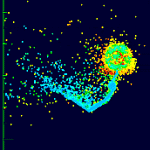The idea that the Moon formed from a giant collision now seems to be the leading theory to explain its existence. One of the most puzzling properties of the Moon is that it has much less iron than does Earth, as evidenced by its much lower mean density, 3.3 times that of water as compared to Earth’s 5.5 times that of water. Another way of saying the same thing is that the Moon is made of material that looks more like rock from Earth’s mantle than like the overall composition of Earth. Thus, one piece of evidence in favor of the impact idea is that the impact blew off rocky material from Earth’s mantle (and from the impactor’s mantle) and this debris formed the Moon. In this scenario, the iron cores of both bodies had already formed, and core material did not make it into Earth orbit. This explains the Moon’s lack of iron.
Another piece of evidence, from the lunar samples, is that the Moon’s composition of certain isotopes exactly matches that of Earth, but it doesn’t match those of bodies from elsewhere in the solar system. Still another positive feature of the collision theory is that it explains the Moon’s lack of water and lightweight volatile compounds: The impact heated the debris to high temperatures, and all volatiles turned to gas and escaped into space.
Alternative theories can’t explain these properties. One older theory, that the Earth and Moon grew side by side, doesn’t explain why one contains iron and the other doesn’t. Another old theory, that the Moon formed far away and was captured by Earth, violates the isotope evidence that they formed in the same location. A third old theory, that the Moon spun off the outer layers of Earth, violates energy and angular momentum considerations. The impact seems to be needed to blow the debris into orbit. — WILLIAM K. HARTMANN, PLANETARY SCIENCE INSTITUTE










